Special Report
Universities Getting the Most Money from the Federal Government

Published:
Last Updated:

The cost of a higher education — which can often help fund world-class research, academic instruction, and state-of-the-art athletic facilities — is infamously high in the United States. Tuition and fees at U.S. universities have increased substantially over the past decade. Largely because of financial aid and other benefits, however, the amount paid out of pocket by students has remained relatively stable over that time.
Many public universities in the United States rely heavily on private funding sources such as tuition payments and gains on endowment assets. Still, the federal government allocates billions of dollars each year to thousands of universities in the form of research and development grants and contracts, as well as financial aid to undergraduates through the Federal Pell Grant Program.
[in-text-ad]
24/7 Wall St. reviewed federally funded research and development grants and Pell Grant disbursements for recipients of financial aid in 1,871 major universities. Johns Hopkins University received nearly $2 billion from the U.S. government in 2015, more than double second-place University of Washington. Yale University rounds out the top 20, receiving approximately $480 million in federal funds in 2015.
Click here to see the universities getting the most money from the federal government.
U.S. research universities spent a combined $68.8 billion on R&D in 2015. The universities on this list have among the largest R&D budgets in the country. Annual R&D expenditure for 10 of the 20 institutions exceeds $1 billion.
As is generally the case across major research universities, federal funds account for most of the R&D spending in all but three of the 20 universities on this list. The reliance on federal funding for university R&D is declining, however. The federal government funded 69% of university research budgets in 1972. By 2015, federally funded research comprised just 55% of total R&D spending, the lowest on record.
This decline is not due to reduced funding, but rather is the result of the expansion of nonfederal funding sources. R&D funding from businesses, nonprofits, and university coffers has increased at twice the rate of federal funding sources since 1972.
Research at top government-funded universities is heavily concentrated in life sciences and engineering fields. Within these fields, medicine is nearly always the largest recipient of research funds — and, as a consequence, federal research grants.
Funding from the U.S. Department of Health and Human Services comprised the largest share of federal grants of any federal agency in 16 of the 20 universities. The principal funding source of the remaining four institutions — Johns Hopkins University, Georgia Institute of Technology, Pennsylvania State University, and the Massachusetts Institute of Technology — is the Department of Defense.
In addition to research funding, Government funding also includes need-based grants to undergraduates awarded through the Federal Pell Grant Program. While across all universities Pell Grant aid totalled $30.6 billion in the 2014-15 school year — on par with the value of research grants — these funds are much more evenly distributed across U.S. universities. Financial aid is generally dwarfed by the size of the federal research grants at these 20 institutions.
To identify the universities receiving the most federal funding, 24/7 Wall St. reviewed the latest government data for 1,871 major universities. To determine total federal funds for each institution, we combined federal R&D funding for the 2015 fiscal year from the National Science Foundation, and Pell Grant disbursements for the 2014-15 school year from the U.S Department of Education.
Total R&D spending by each university, the academic departments receiving funds, and the sources of federal funds by federal agency also came from the NSF. University endowment data came from the National Association of College and University Business Officers and are for the 2016 fiscal year. Enrollment figures were gathered from the Integrated Postsecondary Education Data System of the National Center for Education Statistics and include all students as of Fall 2015.
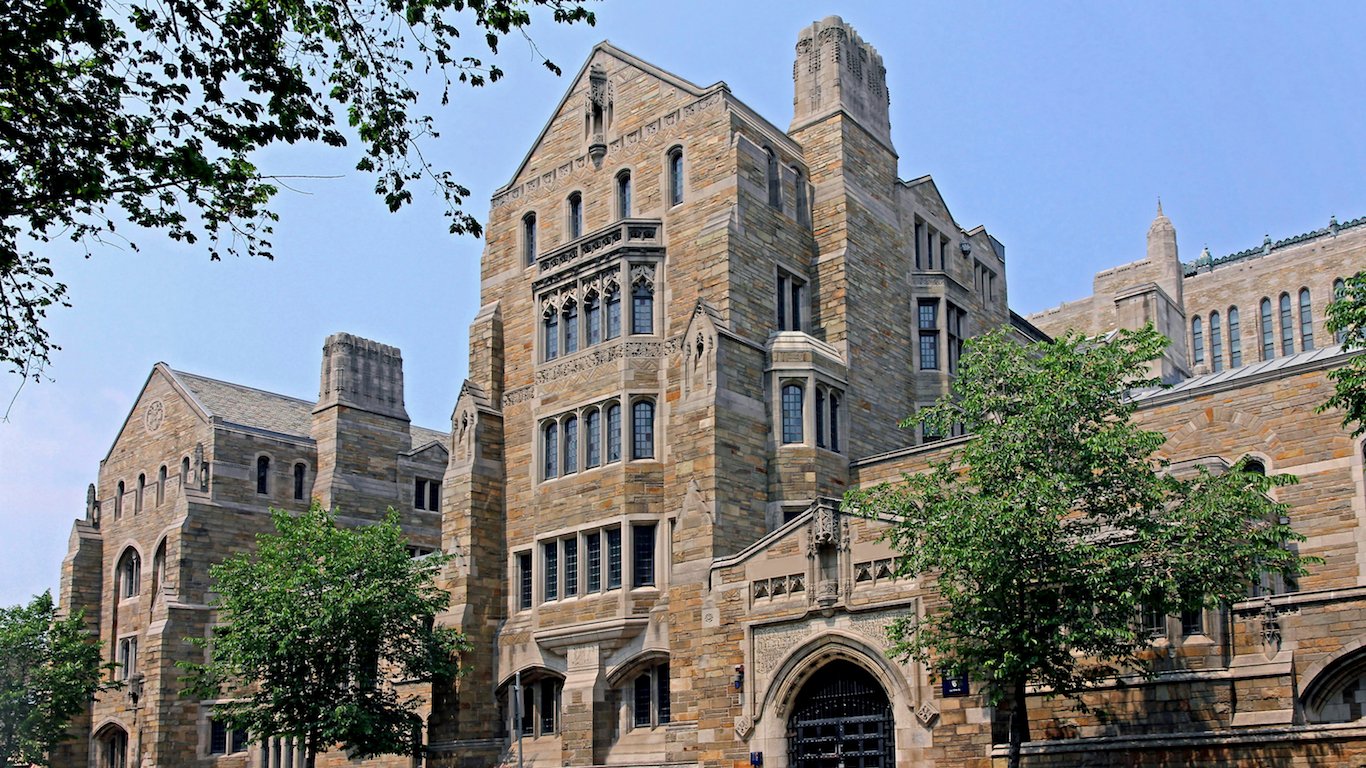
20. Yale University
> Total federal funds: $480.2 million
> Annual R&D expenditure: $803.0 million
> 2015 enrollment: 12,385
> 2016 endowment: $25.4 billion
The federal government transferred $480.2 million in grant and contract money to Yale University in 2015, a larger sum than all but a handful of universities. While $3.0 million of the federal government’s obligations to Yale were in the form of Pell Grants to undergraduates, the remaining $477.1 million were grants and contracts for research and development. Yale dedicated an estimated 83% of its R&D expenditures to life sciences, a bulk of which went to medical research at the Yale School of Medicine. Yale has a history of significant accomplishments in medical research, including the identification of Lyme disease and the creation of the first insulin pump.
[in-text-ad]
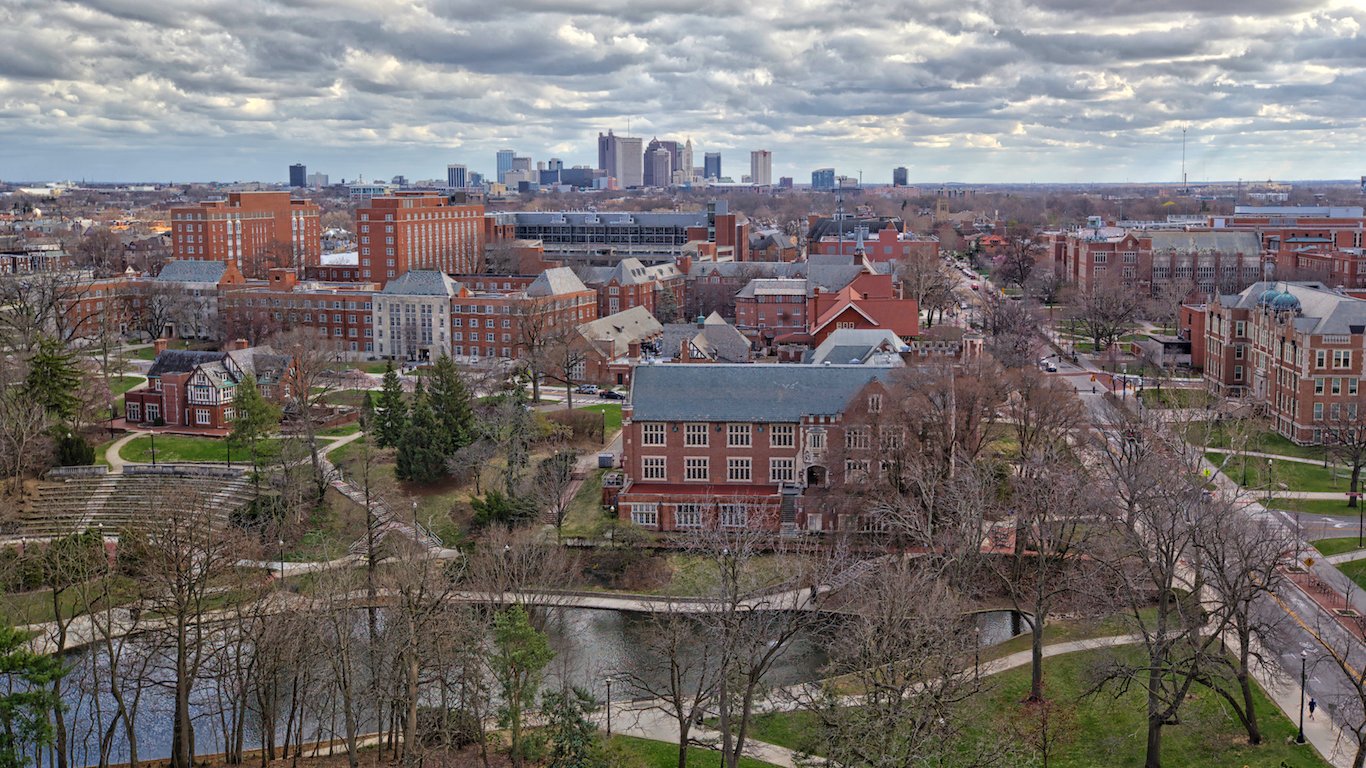
19. Ohio State University
> Total federal funds: $488.0 million
> Annual R&D expenditure: $817.9 million
> 2015 enrollment: 58,663
> 2016 endowment: $3.6 billion
With total enrollment approaching 60,000 students, Ohio State University is one of the largest universities in the country. It is also one of the largest recipients of federal dollars. The U.S. Department of Health and Human Services is the university’s largest source of federal funding. Ohio State spent $817.9 million on R&D in 2015, $446.0 million of which came from the federal government. About $337 million of the university’s R&D spending, or just over 40%, went to medical research. The federal government also disbursed approximately $41.9 million in Pell Grants — need-based financial aid for undergraduates — to OSU students last year.

18. Massachusetts Institute of Technology
> Total federal funds: $491.4 million
> Annual R&D expenditure: $930.7 million
> 2015 enrollment: 11,331
> 2016 endowment: $13.2 billion
MIT is one of the world’s premier research institutions, and the money the U.S. government grants the university each year suggests as much. The school spent $930.7 million on R&D in 2015, more than half of which was provided by the federal government. R&D funds at MIT appears to be well-spent. While a dozen research universities outspent MIT in 2015, only the combined 10 campuses of the University of California system had more patents than MIT’s 278 that year. While many schools that get the most money from the federal government devote a large share to medical research, the lion’s share of R&D spending at MIT — 44.7% — is dedicated to the school’s engineering program.

17. University of Minnesota
> Total federal funds: $505.3 million
> Annual R&D expenditure: $880.6 million
> 2015 enrollment: 50,678
> 2016 endowment: $3.3 billion
One of the largest schools in the country, the University of Minnesota had a total of 50,678 graduates and undergraduates enrolled in the Fall of 2015. While the federal government transferred $476 million in research grants to Minnesota in 2015, the school receives relatively little funding per student. Federal funding for R&D at the school amounts to just $9,393 per student, one of the smaller such figures of any major university. The university’s internal funding sources, which include tuition and donations, account for 31.1% of school R&D spending, a larger share than the 24.3% average for all colleges and universities.
[in-text-ad-2]
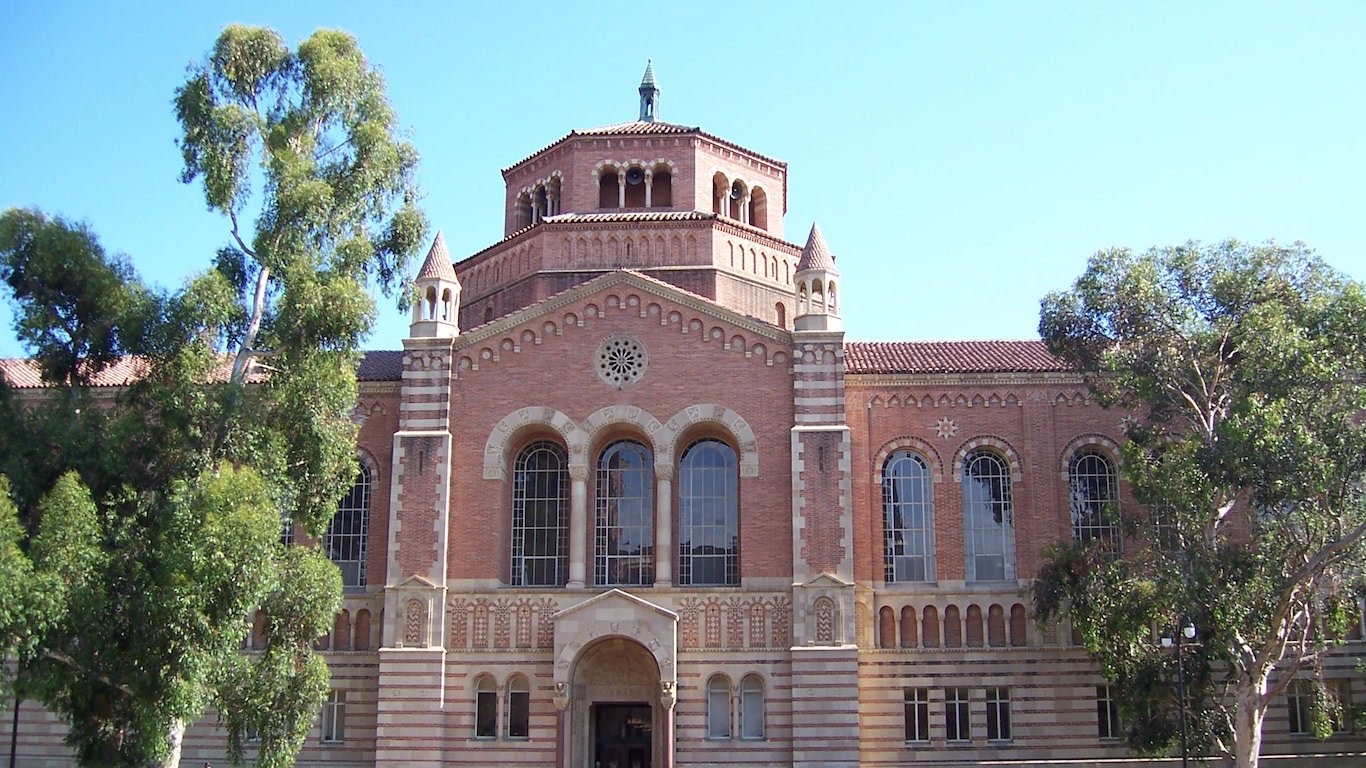
16. University of California, Los Angeles
> Total federal funds: $535.3 million
> Annual R&D expenditure: $1.0 billion
> 2015 enrollment: 41,908
> 2016 endowment: $1.8 billion
The University of California system is one of the strongest research bodies in the country. The university system was granted 489 patents in 2015, the most of any academic body worldwide. University of California, Los Angeles, the largest of UC’s 10 campuses, received $535.3 million in federal grant money in 2015. Roughly 69% of federal funding for UCLA R&D programs comes from the Department of Health & Human Services, which includes the National Institutes of Health.
Since 2011, the NIH has committed more than $150 million to the founding and continued support of UCLA’s Clinical and Translational Science Institute, a partnership with other medical centers and research institutes to enhance biomedical research.

15. University of California, San Francisco
> Total federal funds: $535.5 million
> Annual R&D expenditure: $1.1 billion
> 2015 enrollment: 3,107
> 2016 endowment: $1.1 billion
The San Francisco campus of the University of California school system is just a graduate school, and as a result is the smallest school on this list by far, with a Fall 2015 enrollment of just 3,107. Despite its size, it is one of only 10 higher education institutions in the U.S. to spend more than a $1 billion on R&D in 2015. That year, the school received some $535.5 million in federal grants.
The university is home to the UCSF School of Medicine — one of the most renowned medical schools in the country. As a result, the vast majority of federal research dollars the school receives come from Department of Health and Human Services. The broader University of California system was awarded a combined 489 patents in 2015, more than any other academic body in the world.
[in-text-ad]

14. Harvard University
> Total federal funds: $550.5 million
> Annual R&D expenditure: $1.0 billion
> 2015 enrollment: 29,652
> 2016 endowment: $34.5 billion
While most federal R&D grants are directed to science and engineering projects, Harvard may have more independence in its research due to its $34.5 billion endowment — the largest of any academic institution. Harvard dedicates an estimated 9.6% of its R&D spending to the social sciences, roughly three times the 3.4% average for all universities. The bulk of Harvard’s social science R&D spending is in the field of political science and is financed by the school’s internal funds. Still, like most major research institutions, a majority of Harvard’s R&D expenditures are dedicated to the life sciences and are largely funded by the Department of Health and Human Services.

13. University of Wisconsin-Madison
> Total federal funds: $551.4 million
> Annual R&D expenditure: $1.1 million
> 2015 enrollment: 42,716
> 2016 endowment: $2.4 billion
University of Wisconsin-Madison received $551.4 million from the federal government in 2015, which comprised nearly half of the school’s total R&D spending that year. The school spends most of its R&D dollars on life sciences research, including a substantial amount to biology. The university is home to a one-of-a-kind 1,700 acre arboretum described as the oldest and most diverse restored ecosystem collections in the world. Of the school’s government R&D funding, 51.3% comes from the Department of Health and Human Services, and 16.8% is granted by the National Science Foundation.

12. Georgia Institute of Technology
> Total federal funds: $562.6 million
> Annual R&D expenditure: $765.4 million
> 2015 enrollment: 25,034
> 2016 endowment: $1.8 billion
Georgia Institute of Technology is one of the largest research universities in the world. Georgia Tech was awarded 72 patents in 2015, among the most of any academic institution worldwide. One of the major centers of innovation on campus is Georgia Tech Research Institute, an applied research contractor for the DOD and the largest employer of Georgia Tech students. The Army and the Air Force are the largest sponsors of GTRI research. Likely as a result, the Department of Defense funds 68% of all Georgia Tech R&D spending, nearly the largest share of any school. Life sciences fields are typically the largest recipients of R&D expenditures. Georgia Tech is the exception. The university dedicates about 70% of its R&D spending to engineering projects, compared to 16% universities spend on average on engineering projects.
[in-text-ad-2]
11. Duke University
> Total federal funds: $562.8 million
> Annual R&D expenditure: $1.0 billion
> 2015 enrollment: 15,984
> 2016 endowment: $6.8 billion
Duke University received $562.8 million in federal research funding in 2015, just over half of its total R&D budget. Located in North Carolina, Duke is likely able to make up much of the difference with tuition payments and gains on its substantial endowment. Full tuition at the university is now approximately $60,000 per year. For reference, average annual tuition and fees at private colleges is $33,376, according to U.S. News and World Report. Duke’s endowment of $6.8 billion is one of the nation’s largest.
About 60% of the university’s 2015 R&D spending was in medical sciences. The university owns and operates the Duke University Health System, which includes Duke University Hospital, one of the largest and most renowned hospitals in the country. Duke Health system is one of the largest private employers in the state.

10. University of Pittsburgh
> Total federal funds: $580.3 million
> Annual R&D expenditure: $861.2 million
> 2015 enrollment: 28,649
> 2016 endowment: $3.5 billion
Nearly two-thirds of the University of Pittsburgh’s research spending comes from federal coffers. Of the $561.2 million in federal research grants the university received in 2015, 84.1% came from the Department of Health and Human Services.
In addition to grants and contracts for R&D, the University of Pittsburgh receives a relatively large sum of funding in the form of Pell Grants. Pitt’s 18,908 undergraduates received a total of $19.1 million in Pell Grants in 2015, more than a majority of schools.
In addition to grants and contracts for R&D, the University of Pittsburgh receives a relatively large sum of funding in the form of Pell Grants. Pitt’s 18,908 undergraduates received a total of $20.6 million in Pell Grants in 2016, more than a majority of schools.
[in-text-ad]
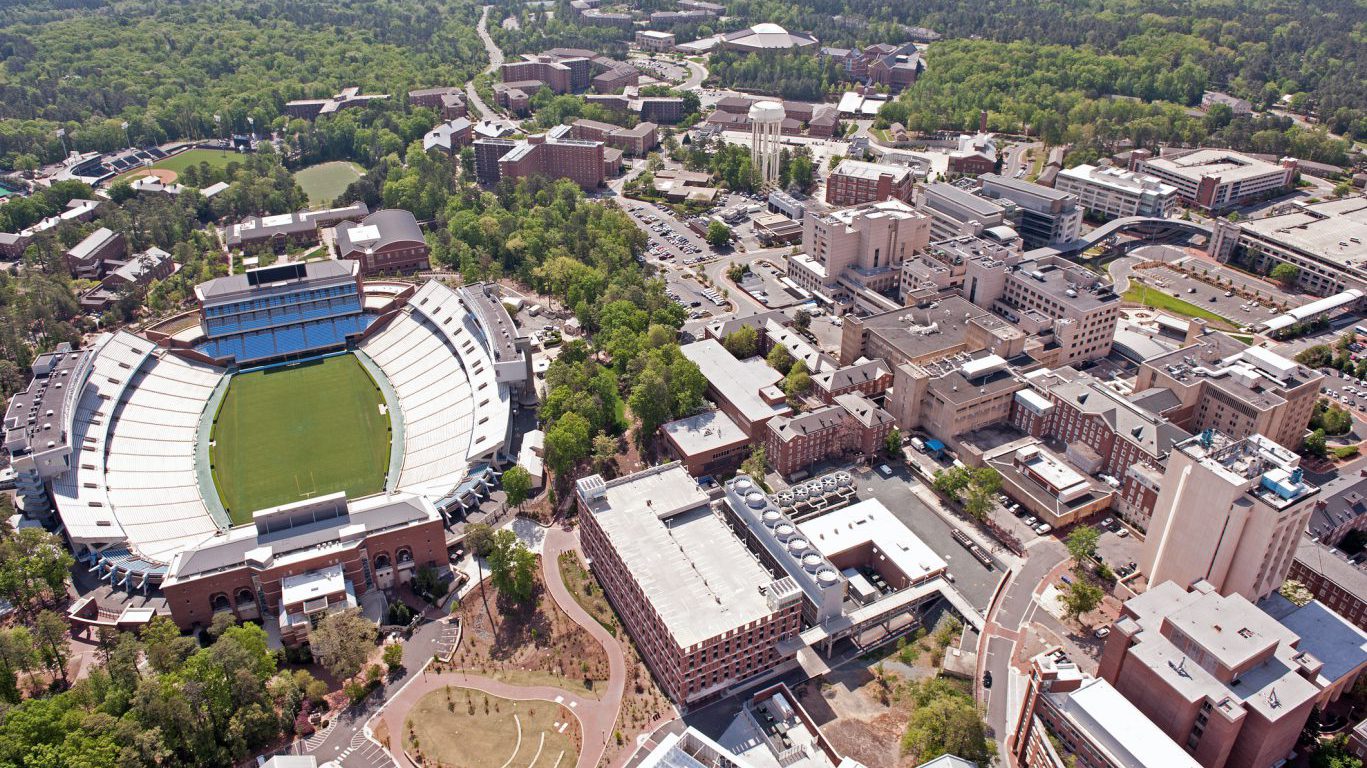
9. The University of North Carolina at Chapel Hill
> Total federal funds: $599.2 million
> Annual R&D expenditure: $966.8 million
> 2015 enrollment: 29,084
> 2016 endowment: $2.9 billion
The University of North Carolina at Chapel Hill received $599.2 million in federal grant money in 2015, the fifth most of any public university. Like most large research institutions, UNC allocated most of its R&D funds toward research in life sciences such as medicine and biology. Most of this funding came from the Department of Health and Human Services. However, the school also dedicates outsized portions of its R&D budget toward research in psychology and the social sciences. An estimated 4.8% of UNC’s total R&D spending goes to psychology research, compared to the 1.7% average for all universities. UNC also dedicates 9.2% of its total R&D spending to research in the social sciences, nearly three times the 3.4% average.
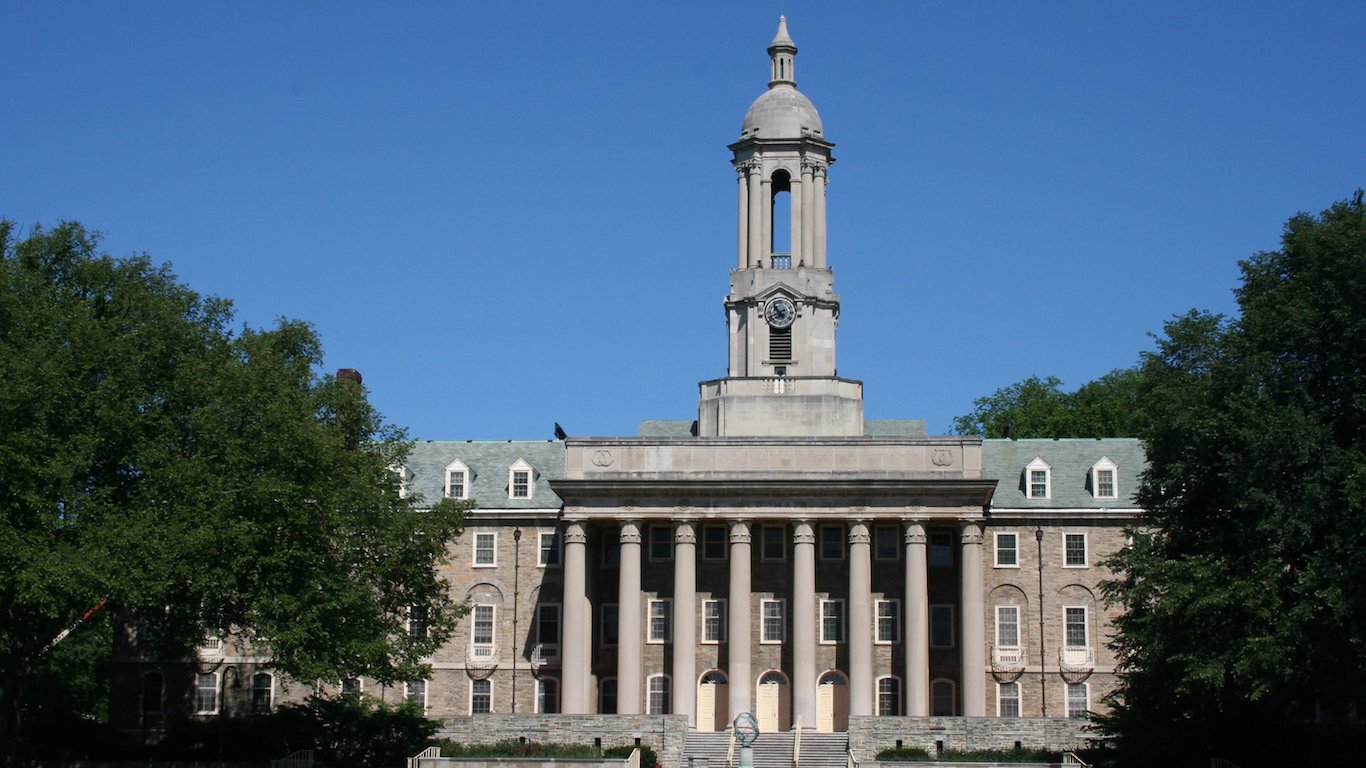
8. The Pennsylvania State University
> Total federal funds: $599.8 million
> Annual R&D expenditure: $791.0 million
> 2015 enrollment: 47,307
> 2016 endowment: $3.6 billion
Pennsylvania State University is one of the largest research partners of the U.S. Navy. Established in 1945 as a U.S. Navy University Affiliated Research Center, Penn State Applied Research Laboratory has conducted research in fluid dynamics, acoustics, and undersea weapons in support and development of naval technology. The Navy is a division of the Department of Defense, which funds 40.4% of Penn State’s total R&D activity, far more than the 13.5% average for all universities.
Penn State also funds 5.4% of its R&D with grants from the U.S. Department of Agriculture, one of the largest shares of any school. At the end of 2016, the USDA awarded Penn State a $471,000 grant for a project studying the role of biodiversity in crop yields.
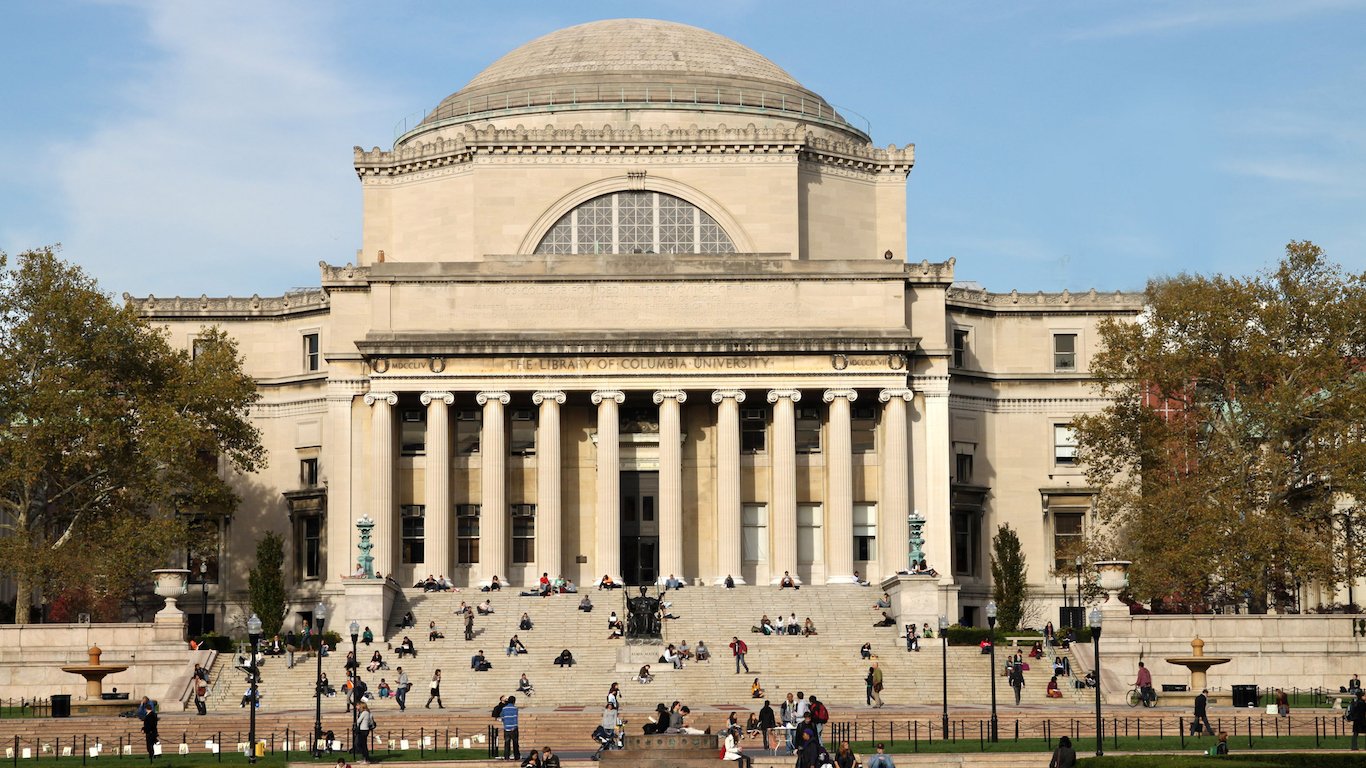
7. Columbia University in the City of New York
> Total federal funds: $599.9 million
> Annual R&D expenditure: $868.2 million
> 2015 enrollment: 28,086
> 2016 endowment: $9.0 billion
Columbia University is one of four Ivy League schools receiving more than $450 million in federal funds for R&D. Along with state government funds, nonprofit funding, and money from the school’s own coffers, Columbia spent $868.2 million on R&D in 2015. That same year, Columbia was awarded 119 patents, easily ranking it among the most innovative universities in the nation. The majority of R&D spending at the school goes toward life sciences research and encompasses a range of pursuits, from the ecology of tick-borne illnesses to neuroscience and the study of Alzheimer’s disease.
[in-text-ad-2]
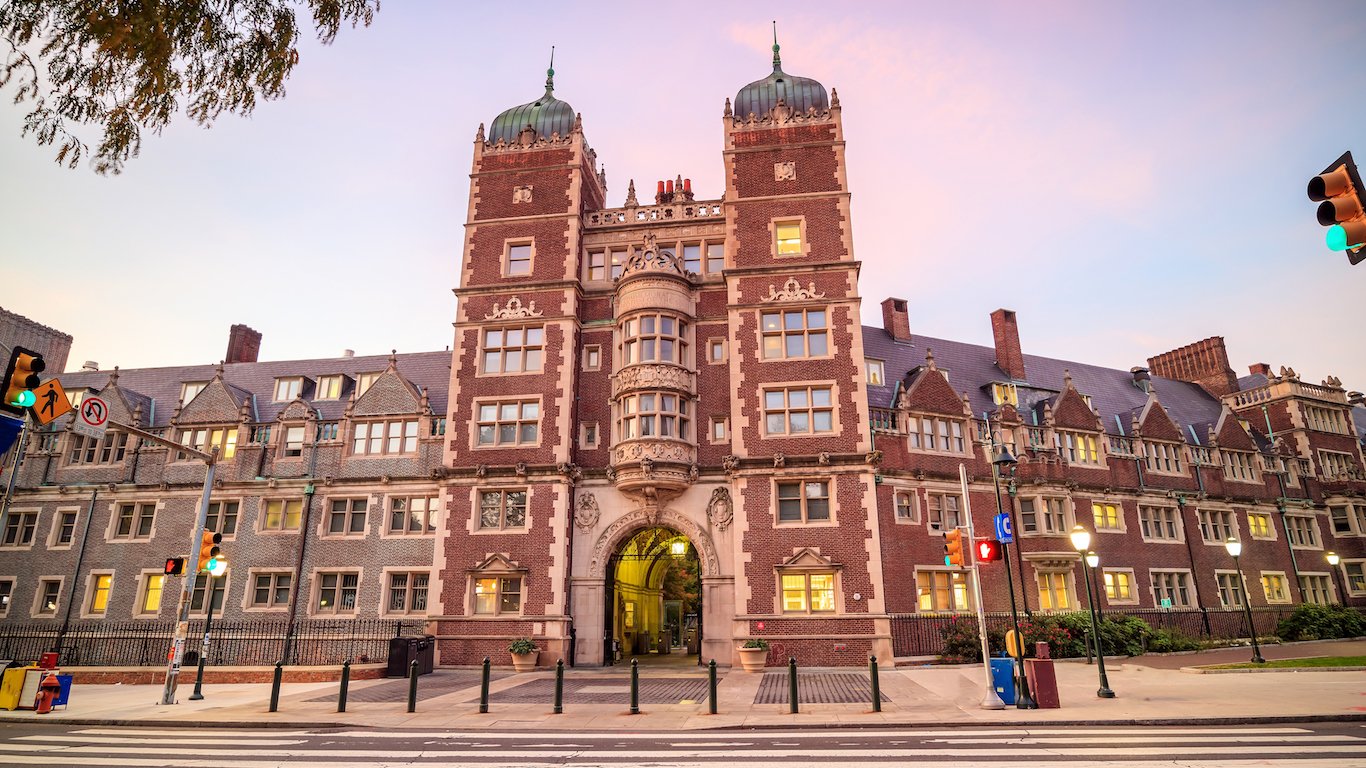
6. University of Pennsylvania
> Total federal funds: $617.5 million
> Annual R&D expenditure: $864.1 million
> 2015 enrollment: 24,876
> 2016 endowment: $10.7 billion
The University of Pennsylvania received $617.5 million in federal funding in 2015, more than any other Ivy League institution. Like nearly every other school on this list, the vast majority of government research funding comes from the Department of Health and Human Services.
Recently, the university began integrating its research findings with other academic disciplines. Under University President Amy Gutmann, the school purchased and renovated at the end of last year an old DuPont industrial site. The facility was converted into a 58,000 square foot laboratory and is intended to commercialize research discoveries.

5. University of California, San Diego
> Total federal funds: $643.0 million
> Annual R&D expenditure: $1.1 billion
> 2015 enrollment: 32,906
> 2016 endowment: $536.1 million
Several University of California campuses are among the largest recipients of federal grants in the country. UC San Diego is not the largest UC school , but the university received about $108 million more in federal grants than the next largest federal funding recipient in the UC system.
Only slightly over one-third of enrolled undergraduates in 2015 were Pell Grant recipients, which is one of the smallest shares among UC schools. As is the case for all the schools receiving the most money from the federal government, the vast majority of San Diego’s federal funding comes through R&D grants. The University of California system received 489 U.S. utility patents in 2015, nearly double the patents awarded to MIT, the second largest recipient.
[in-text-ad]
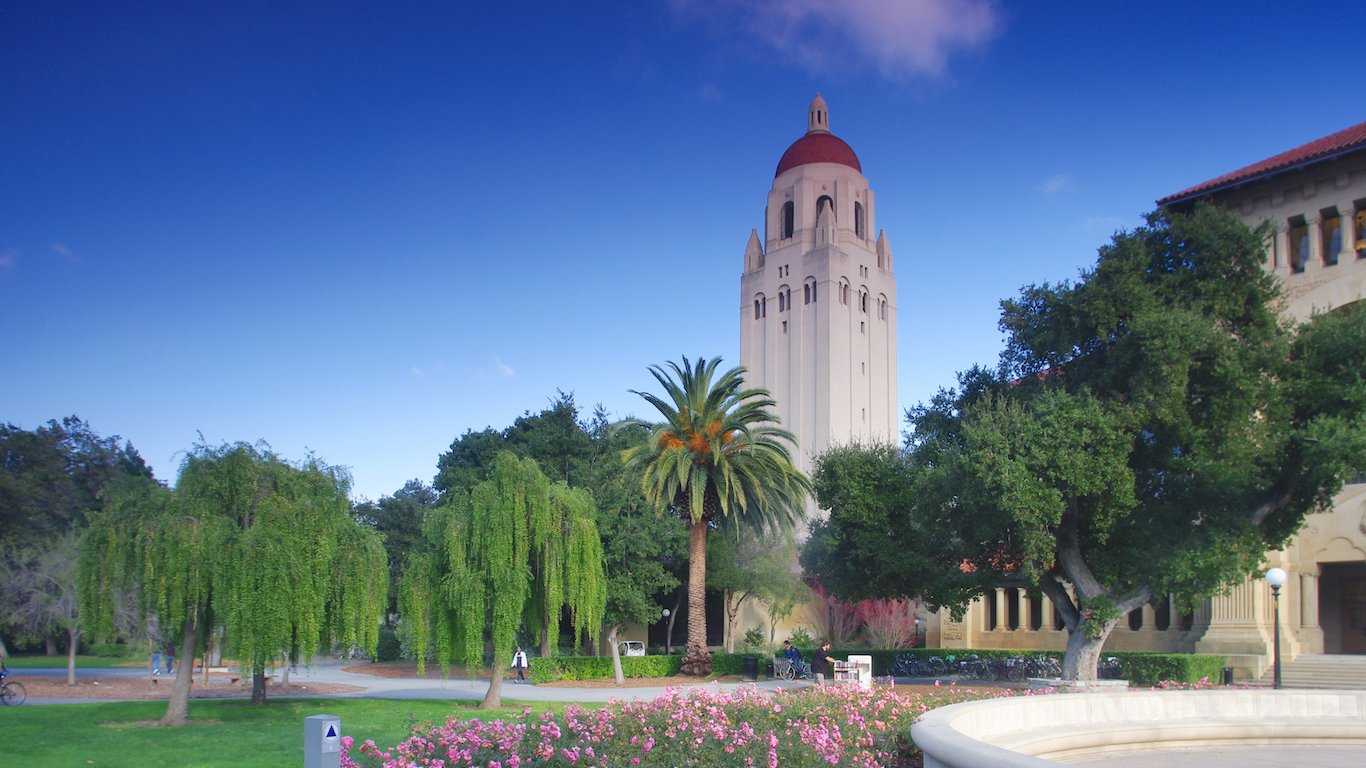
4. Stanford University
> Total federal funds: $679.6 million
> Annual R&D expenditure: $1.0 billion
> 2015 enrollment: 16,980
> 2016 endowment: $22.4 billion
While the federal government provides Stanford most of its R&D funding, private corporations provide a relatively large share of the university’s research funding. An estimated 8.8% of all Stanford R&D spending is funded by private businesses, one of the largest shares of any university.
The university’s Office of Technology Licensing, through its work with Silicon Valley tech firms, has helped support Stanford’s strong relationship with private enterprise. The OTL helps students and faculty license their inventions and find business applications for their research. Stanford was awarded a total of 205 patents in 2015, the most of any academic institution other than MIT and the University of California system.
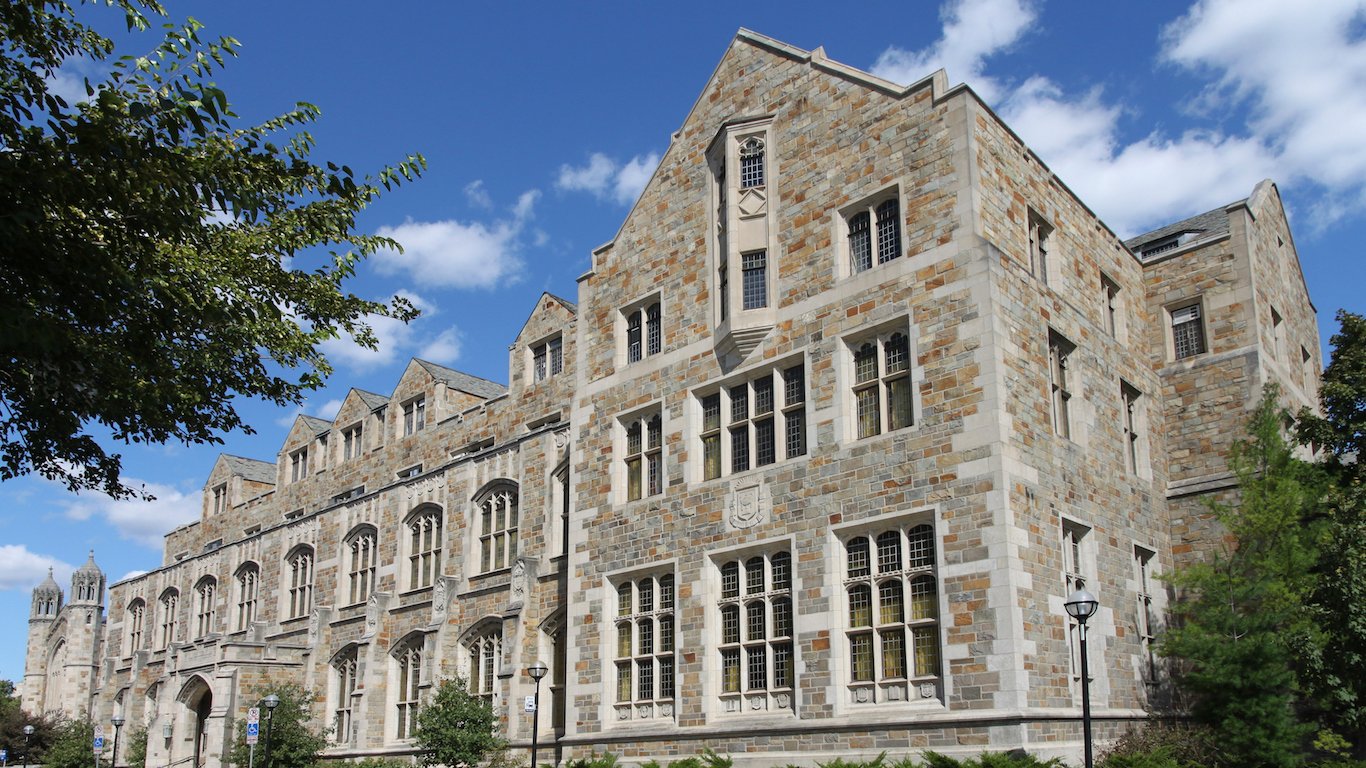
3. University of Michigan
> Total federal funds: $756.1 million
> Annual R&D expenditure: $1.4 billion
> 2015 enrollment: 43,651
> 2016 endowment: $9.7 billion
One of the largest schools in the in the country, the University of Michigan receives significant federal funding. The school received over three-quarters of a billion dollars in 2015 from a range of government agencies, including the Department of Defense, the National Science Foundation, the Department of Energy, and the Department of Health and Human Services.
The University of Michigan allocated 10.9% of of its $1.4 billion R&D budget to social sciences, a larger share than any other school on this list. The school’s Institute for Social Research has made a number of important contributions to the field in its 68 year history, including the founding of the study of organizational behavior and conducting the trials that confirmed the Salk polio vaccine was safe for public use.

2. University of Washington
> Total federal funds: $960.6 million
> Annual R&D expenditure: $1.2 billion
> 2015 enrollment: 45,408
> 2016 endowment: $3.0 billion
Seattle’s University of Washington is one of the larger postsecondary institutions in the country, with enrollment over 45,000. The university received more than $960 million in federal funding, about $54 million of which came in the form of Pell Grants. However, like most schools on this list, most federal funds disbursed to UW go to research and development. The university spent approximately $1.2 billion on research and development, $907 million of which came from the U.S. government. Of that, the university allocated the largest share — about $500 million — to medical sciences. Another $130 million went to engineering research.
[in-text-ad-2]

1. Johns Hopkins University
> Total federal funds: $2.0 billion
> Annual R&D expenditure: $2.3 billion
> 2015 enrollment: 22,686
> 2016 endowment: $3.4 billion
With $2.0 billion in federal R&D funding in 2015, Johns Hopkins University is the largest university research partner of the federal government. One of the major centers of innovation on campus is the Applied Physics Laboratory. Established in 1942, the APL has provided the Department of Defense with research in missile defense, space, and weapons systems. The DOD funds 40% of Johns Hopkins annual R&D spending, compared to the 14% average for all universities. NASA funds account for 11% of the school’s R&D expenditure, compared to the 4% average. Among the school’s many research accomplishments, Johns Hopkins was responsible for the first spacecraft to land on an asteroid and helped develop the first effective treatment for sickle cell anemia.
Ever wanted an extra set of eyes on an investment you’re considering? Now you can speak with up to 3 financial experts in your area for FREE. By simply
clicking here you can begin to match with financial professionals who can help guide you through the financial decisions you’re making. And the best part? The first conversation with them is free.
Click here to match with up to 3 financial pros who would be excited to help you make financial decisions.
Thank you for reading! Have some feedback for us?
Contact the 24/7 Wall St. editorial team.